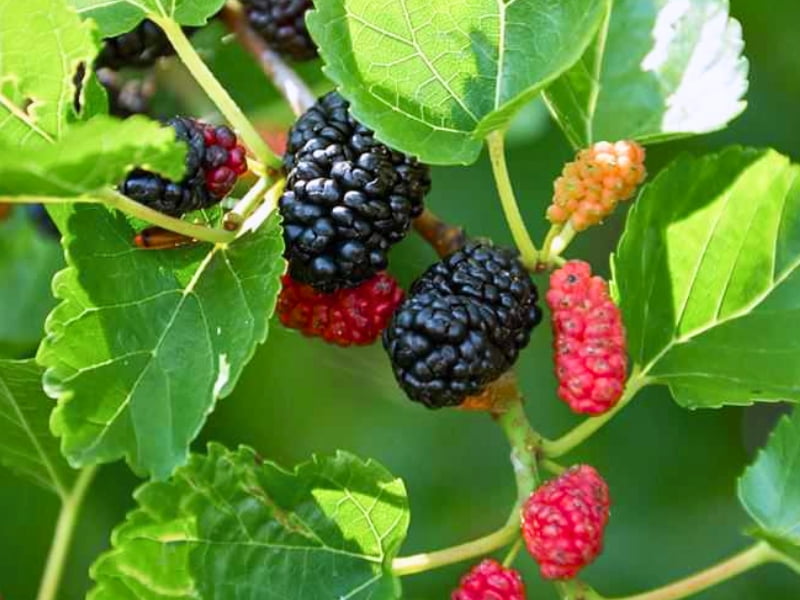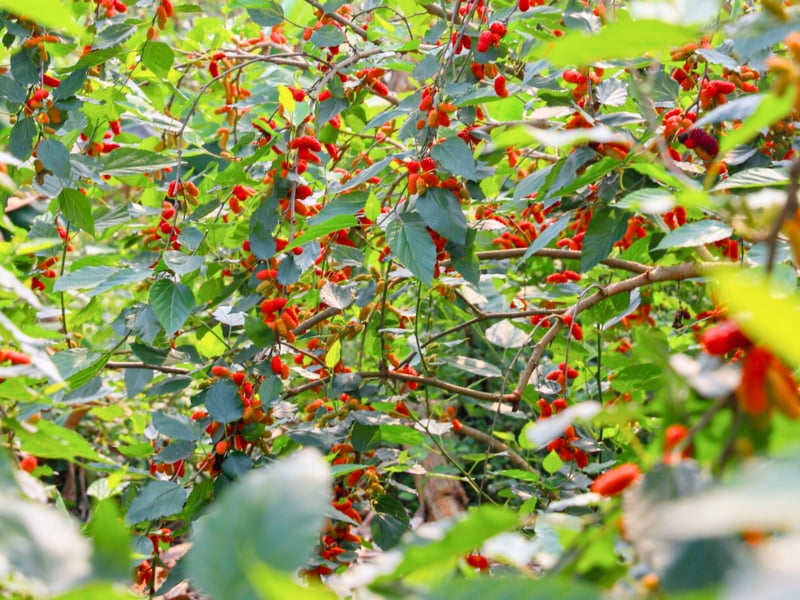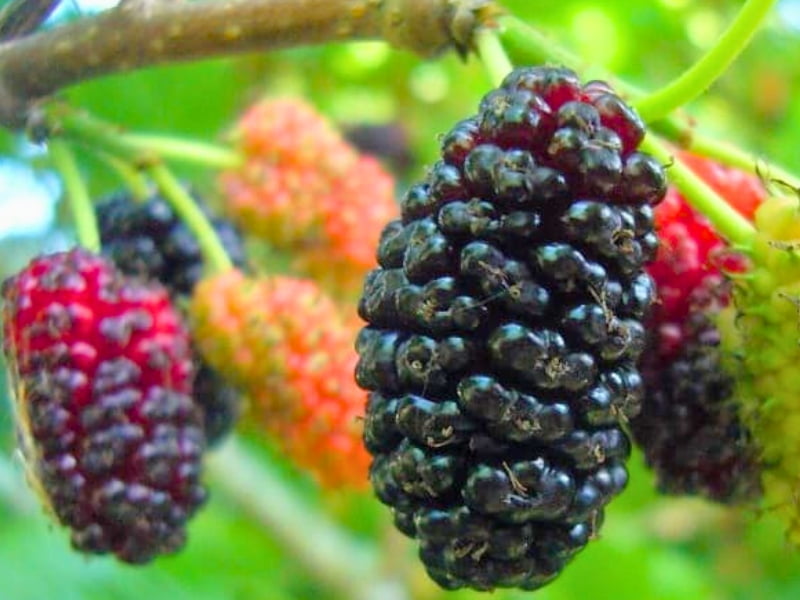Apache Blackberry Bush, also commonly known as the thornless Apache blackberry or by its botanical name Rubus ‘Apache’, is a fantastic addition to any home garden, offering sweet, large berries and easy maintenance. This cultivar is prized for its upright, thornless canes, making harvesting a breeze and reducing the risk of scratches.
At Gardencenterpoint.com, we believe in empowering gardeners with the knowledge to succeed. This guide will provide comprehensive information on planting, growing conditions, and even buying your own Apache Blackberry shrub, so you can enjoy a bountiful harvest year after year.

What is an Apache Blackberry Bush?
The Apache Blackberry Bush is a floricane-fruiting blackberry cultivar developed by the University of Arkansas, released in 1999. It’s a member of the Rosaceae family, the same family as roses, apples, and strawberries. This specific variety is renowned for its large, firm, and sweet berries, but its most distinguishing feature is its thornless canes. This makes it a favorite among home gardeners and commercial growers alike, as it significantly simplifies the harvesting process and eliminates the risk of painful scratches.
| Common name | Apache Blackberry, Thornless Blackberry |
| Botanical name | Rubus ‘Apache’ |
| Family | Rosaceae |
| Genus | Rubus |
| Species | The Apache is a hybrid, so it doesn’t have a specific species designation in the same way a wild plant would. It’s part of the Rubus genus, within the blackberry aggregate. |
| Origin | Developed at the University of Arkansas, USA |
| Native | While cultivated widely, its origin is a specific breeding program in the USA. |
| Life cycle | Perennial |
| Plant type | Deciduous Shrub (Cane fruit) |
| Hardiness zone | USDA Zones 5-9. Some sources indicate it can tolerate Zone 4 with adequate winter protection. |
| Sunlight | Full Sun (at least 6-8 hours of direct sunlight per day) |
| Maintenance | Moderate. Requires annual pruning and ongoing care for optimal fruit production. |
| Water | Moderate. Regular watering is essential, especially during fruit development, but avoid overwatering. |
| Drainage | Well-Drained. Blackberries are susceptible to root rot in soggy soil. |
| Spacing | 3-4 feet between plants within a row, and 8-10 feet between rows. |
| Flowering period | Late Spring (typically May, but this varies by location and climate) |
| Height | 5-8 feet tall, with some canes potentially reaching longer lengths if not pruned. |
| Width | 3-4 feet wide (the spacing distance). |
| Growth rate | Fast |
| Flower color | White |
| Fruit Color | Black |
| Stem color | Green when young, turning reddish-brown with age. |
| Fruit benefit | High Yield, Large Fruit Size, Excellent Flavor, Good Storage Quality |
| Garden style | Edible Garden, Fruit Garden, Cottage Garden |
| Uses | Fresh Eating, Jams, Jellies, Pies, Cobblers, Smoothies, Freezing |
| Soil pH | Slightly acidic (6.0-6.8 is ideal) |
| Chill Hours | 800-900 hours (This is the number of hours below 45°F / 7°C the plant needs during dormancy to produce fruit properly). This requirement is met well within the Hardiness |
| Disease Resistance | Generally good resistance to many common blackberry diseases, but monitoring is still recommended. Specifically noted for resistance to double blossom/rosette. |
| Thorns | Thornless |
| Pollination | Self-pollinating, but planting multiple blackberry varieties (even other thornless types) can sometimes improve fruit set and yield. |
The Apache blackberry is a product of extensive breeding efforts aimed at combining desirable traits like high yield, large fruit size, excellent flavor, and disease resistance. Dr. John R. Clark and Dr. James N. Moore are credited with the development of this exceptional variety. Their work at the University of Arkansas has revolutionized blackberry cultivation, making it more accessible and enjoyable for gardeners of all skill levels.
The plant itself is characterized by its erect growth habit. Unlike some trailing blackberry varieties that require extensive trellising, the Apache’s strong, upright canes can often support themselves, although some support can still be beneficial, especially when laden with fruit. The canes typically reach a height of 5-8 feet, and the plant can spread to a similar width if not pruned.
The berries produced by the Apache Blackberry Bush are exceptionally large, often exceeding 1.5 inches in length. They have a glossy black appearance when fully ripe and a firm texture that holds up well during picking and storage. The flavor is described as sweet and rich, with a classic blackberry taste that is perfect for fresh eating, jams, jellies, pies, and other culinary uses.
The Apache Blackberry Bush’s floricane fruiting habit means that it produces fruit on second-year canes (floricanes). The first-year canes (primocanes) grow vegetatively, developing the buds that will flower and fruit the following year. Understanding this growth cycle is crucial for proper pruning, as removing the floricanes after they have fruited is essential for maintaining a healthy and productive plant.
A study in the Journal of the American Pomological Society found that the Apache variety consistently outperformed other thornless blackberry cultivars in terms of yield and fruit size in trials conducted across various locations. This research underscores the Apache’s reliability and its potential to produce abundant harvests in diverse climates. The University of Arkansas System Division of Agriculture continues to recommend the Apache as a top choice for both home gardeners and commercial growers in 2024.
Why Choose the Apache Variety?
Choosing the right blackberry variety for your garden can be a significant decision. There are numerous cultivars available, each with its own unique characteristics. However, the Apache Blackberry Bush stands out for several compelling reasons:
- Thornless Canes: This is arguably the most significant advantage of the Apache. The absence of thorns dramatically simplifies harvesting, making it a more pleasant experience, especially for families with children. You can reach deep into the bush to collect the ripe berries without fear of scratches or snags.
- Large, Sweet Berries: The Apache produces exceptionally large berries, often exceeding the size of many other varieties. These berries are not only visually impressive but also boast a rich, sweet flavor that is perfect for a variety of culinary uses.
- High Yields: The Apache is known for its high productivity. A well-maintained plant can produce a substantial quantity of berries, providing ample fruit for fresh eating, preserving, and sharing with friends and family.
- Erect Growth Habit: The strong, upright canes of the Apache minimize the need for extensive trellising. While some support can be helpful, it’s less demanding than the sprawling growth habit of trailing blackberry varieties.
- Disease Resistance: The Apache has been bred for good resistance to several common blackberry diseases, including orange rust and double blossom. This reduces the need for chemical treatments and makes it a more sustainable choice for home gardeners.
- Excellent Flavor: Beyond their size, Apache blackberries are prized for their delicious flavor. They are sweet, juicy, and have a classic blackberry taste that is highly sought after.
- Adaptability: According to the University of Arkansas, Apache Blackberry shows good cold hardiness to -10°F (-23°C).
The combination of these traits makes the Apache Blackberry Bush a highly desirable choice for gardeners of all levels of experience. Whether you’re a seasoned fruit grower or a beginner just starting out, the Apache offers a rewarding and relatively low-maintenance way to enjoy fresh, homegrown blackberries. The University of Georgia Extension also recommends the Apache variety for its ease of cultivation and high-quality fruit, further solidifying its reputation as a top-performing cultivar.

Planting Apache Blackberry Bush
Planting your Apache Blackberry Bush correctly is the first crucial step towards a bountiful harvest. Follow these steps for optimal results:
Site Selection: Sun, Soil, and Space
Sunlight: Apache Blackberries thrive in full sun, requiring at least 6-8 hours of direct sunlight per day. Choose a location that receives ample sunlight throughout the growing season.
Soil: Well-drained soil is essential. Blackberries do not tolerate waterlogged conditions. The ideal soil pH is between 5.5 and 6.5. Amend heavy clay soil with organic matter, such as compost or well-rotted manure, to improve drainage and aeration. A soil test can help determine the pH and nutrient levels, allowing you to make necessary adjustments before planting.
Space: Allow adequate space for your plants to grow. Space plants 3-4 feet apart within rows, and allow 8-10 feet between rows. This spacing provides good air circulation, which helps prevent diseases, and allows ample room for the plants to mature.
When to Plant
The best time to plant bare-root blackberry bushes is in late fall or early spring, while the plants are dormant. Container-grown plants can be planted throughout the growing season, but spring or fall planting is still preferred. Avoid planting during periods of extreme heat or cold.
The Planting Process
Prepare the Planting Hole: Dig a hole that is twice as wide and as deep as the root ball of the plant.
Amend the Soil (if necessary): If your soil test indicated a need for amendments, mix the removed soil with compost, well-rotted manure, or other organic matter.
Position the Plant: Gently place the blackberry bush in the hole, ensuring that the top of the root ball is level with the surrounding soil surface. For bare-root plants, spread the roots out gently in the hole.
Backfill the Hole: Fill the hole with the amended soil, gently firming it around the roots to eliminate air pockets. Avoid compacting the soil excessively.
Create a Watering Basin: Form a shallow basin around the base of the plant to help retain water.
Initial Watering and Care
Water the newly planted bush thoroughly, soaking the soil deeply. This helps settle the soil and encourages root establishment.
Apply a layer of mulch, such as wood chips or straw, around the base of the plant, keeping it a few inches away from the canes. Mulch helps retain moisture, suppress weeds, and regulate soil temperature.
Ongoing Maintenance
Proper care and maintenance are essential for maximizing the health, productivity, and longevity of your Apache Blackberry Bush.
Watering: Finding the Right Balance
Blackberries require consistent moisture, especially during fruit development. Aim for about 1 inch of water per week, either from rainfall or supplemental irrigation.
Water deeply and less frequently, rather than shallowly and more often. This encourages deep root growth, making the plant more drought-tolerant.
Use a soaker hose or drip irrigation to deliver water directly to the root zone, minimizing water loss through evaporation and reducing the risk of foliar diseases.
Monitor soil moisture regularly, especially during hot, dry periods. Adjust your watering schedule as needed to maintain consistent moisture levels.
Fertilizing: Feeding Your Plant for Optimal Growth
Balanced Fertilizer: A balanced fertilizer, such as 10-10-10, provides a good mix of nitrogen, phosphorus, and potassium, essential nutrients for overall plant growth and fruit production.
Organic Options: Compost, well-rotted manure, and other organic fertilizers can also be used to provide nutrients and improve soil health.
Fertilization schedule
- Apply fertilizer in early spring, before new growth emerges, and again after harvest.
- Follow the instructions on the fertilizer package for application rates. Avoid over-fertilizing, as this can lead to excessive vegetative growth and reduced fruit production.
- A soil test can help determine specific nutrient needs and guide your fertilization strategy.
Pruning
Pruning is crucial for maintaining the health and productivity of your Apache Blackberry Bush.
Summer Pruning: After harvest, remove the floricanes (the canes that fruited) by cutting them back to the ground. This encourages the growth of new primocanes, which will produce fruit the following year.
Dormant Pruning (Late Winter/Early Spring): Thin out the primocanes, leaving 6-8 of the strongest, healthiest canes per plant. Shorten the remaining canes to a height of 4-5 feet. Remove any weak, damaged, or crossing canes.
Proper pruning improves air circulation, reduces disease risk, and directs the plant’s energy towards fruit production.
Pest and Disease Control
The Apache Blackberry Bush is generally resistant to many common diseases, but it’s still important to monitor for potential problems.
Common Pests
Japanese Beetles: These beetles can skeletonize leaves and damage fruit. Hand-picking, traps, and insecticides can be used for control.
Aphids: These small, sap-sucking insects can weaken plants and transmit diseases. Insecticidal soap or neem oil can be effective treatments.
Spider Mites: These tiny pests can cause stippling and yellowing of leaves. Insecticidal soap or miticides can be used for control.
Common Diseases
Orange Rust: This fungal disease causes bright orange pustules on the leaves. Remove and destroy infected canes.
Double Blossom (Rosette): This fungal disease causes distorted flowers and fruit. Prune out infected canes and improve air circulation.
Anthracnose: This fungal disease causes lesions on canes and leaves. Proper pruning and fungicide applications can help control it.
Preventative Measures
- Choose a sunny, well-drained location.
- Practice proper pruning to improve air circulation.
- Water at the base of the plant to avoid wetting the foliage.
- Monitor your plants regularly for signs of pests or diseases.
- Remove and destroy any infected plant material.
Weed Control
- Weeds compete with your blackberry bushes for water, nutrients, and sunlight.
- Mulching is an effective way to suppress weeds.
- Hand-weeding or hoeing can be used to remove weeds that emerge.
- Avoid using herbicides near your blackberry bushes, as they can damage the plants.
Winter Protection
In colder climates, some winter protection may be necessary.
After the first hard frost, apply a thick layer of mulch, such as straw or shredded leaves, around the base of the plant.
In very cold regions, you may need to cover the plants with burlap or frost blankets.
Remove winter protection in spring, after the danger of frost has passed.

Harvesting Your Apache Blackberries
- 5. 1. Ripening Signs
- Apache Blackberries are at their peak when they have turned a deep, glossy black color.
- They will be plump, slightly soft to the touch, and easily detach from the stem with a gentle tug.
- Green or reddish berries are not yet ripe and will be sour.
- 5.2 Harvesting
- Harvest your blackberries in the morning, after the dew has dried.
- Gently grasp the ripe berries and pull them from the stem.
- Place the berries in shallow containers to prevent crushing.
- Harvest regularly, every few days, to encourage continued fruit production.
- Freshly picked blackberries are best enjoyed immediately or stored in the refrigerator for a few days. They can also be frozen for longer-term storage.
Propagating Apache Blackberry Bushes
Expanding your blackberry patch or sharing plants with friends is easy with these propagation methods:
Tip Layering
- In late summer, select a healthy, low-growing primocane.
- Bend the tip of the cane down to the ground.
- Bury the tip of the cane a few inches deep in the soil, securing it with a rock or landscape pin.
- Keep the soil moist.
- Roots will develop at the buried tip over the winter.
- In the spring, sever the new plant from the parent plant and transplant it to a new location.
Suckers
- Apache Blackberry Bushes produce suckers, which are new shoots that arise from the roots.
- In the spring, carefully dig up the suckers, ensuring that you get a good portion of the root system.
- Transplant the suckers to a new location, following the same planting instructions as for new plants.
Common Problems and Solutions
While the Apache Blackberry Bush is relatively low-maintenance, you may encounter some common problems:
- Problem: Yellowing Leaves
- Possible Causes: Nutrient deficiency, poor drainage, overwatering, or pest infestation.
- Solutions: Conduct a soil test, improve drainage, adjust watering, or treat for pests.
- Problem: Poor Fruit Production
- Possible Causes: Lack of sunlight, insufficient pruning, poor pollination, or nutrient deficiency.
- Solutions: Ensure adequate sunlight, prune properly, encourage pollinators, or fertilize.
- Problem: Wilting Canes
- Possible Causes: Lack of water, root rot, or disease.
- Solutions: Water deeply, improve drainage, or treat for disease.
- Problem: Small Berries.
- Possible Causes: Insufficient watering during fruiting stage, nutrient deficiencies, overcrowding.
- Solutions: Increase watering during berry development, fertilize as needed, prune to ensure proper spacing.
Comparing Apache Blackberries to Other Varieties
| Feature | Apache | Navaho | Ouachita | Chester | Triple Crown |
| Thornless | Yes | Yes | Yes | Yes | Yes |
| Fruit Size | Very Large | Large | Large | Medium | Large |
| Flavor | Sweet, Rich | Sweet | Sweet, Slightly Tart | Sweet, Mild | Sweet, Slightly Tart |
| Growth Habit | Erect | Erect | Erect | Semi-Erect | Semi-Erect |
| Yield | High | High | High | Moderate | Very High |
| Disease Resistance | Good | Good | Good | Moderate | Good |
| Cold Hardiness | to -10°F (-23°C) | to -14°F (-26°C) | to 5°F (-15°C) | to -10°F (-23°C) | to -5°F (-20°C) |
| Ripening Time | Mid-Season | Mid-Season | Mid-Season | Late Season | Mid-Late Season |
This table provides a comparison of the Apache Blackberry Bush to other popular thornless varieties. The best choice for your garden will depend on your specific needs and preferences.
Where to Buy Apache Blackberry Bushes
Apache Blackberry Bushes are widely available from various sources:
- Local Nurseries and Garden Centers: Check with your local nurseries and garden centers, especially those that specialize in fruit trees and shrubs.
- Online Retailers: Many online retailers offer Apache Blackberry Bushes, often in both bare-root and container-grown forms.
- Mail-Order Catalogs: Some mail-order catalogs that specialize in fruit plants also carry the Apache variety.
When purchasing your plants, choose healthy, vigorous specimens with well-developed root systems. Inspect the canes for any signs of damage or disease.
